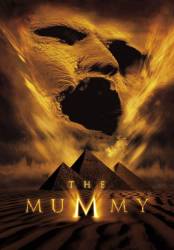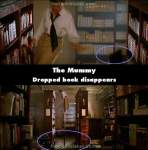Question: What did Beni say when he was swearing in Hungarian?
Answer: Goblin Dick.
Question: Why is it said that Imhotep and his priests were mummified alive? Mummification occurs when someone dies and has most of the organs removed. Wouldn't it be more accurate to say that he was buried alive?
Answer: It means the process of removing their organs was performed while they were still alive. Certainly at some point they would die during the process from blood loss or having a vital organ removed. And it was just the priests that were mummified alive, Imhotep was subjected to a different punishment.
Their internal organs were not removed or they'd die instantly. In the movie you see them being bandaged up and put in the sarcophaguses whilst still moving and then sealed up so they still had their organs. It is indeed more like being buried alive but then as a mummy.
Indeed, but you can also see the Medjai using sharp tools against some of the priests. The priest on the left side of the screen with his arm writhing has a Medjai placing a sharp object around his face, indicating he might either be cutting out his tongue or removing his brains through his nose. The Medjai in the immediate foreground is (badly) making a slashing motion with his sword towards the priest lying on the table before him.
Question: Evie constantly refers to the 'Bembrige Scholars' - do they actually exist?
Chosen answer: No, but it sounds a bit like Cambridge or some other old institution. Bembridge actually exists as a village in England, but there is no mention anywhere of any institution or society named "Bembridge Scholars", so it's most likely something that was invented for the sake of the franchise, as they are mentioned in the second movie as well.
Question: What does Colonel O'Connell yell to his Legionnaires in French as the cavalry charge nears? And why does he then continue in English ("Steady, Steady...Fire!").
Answer: He is in the French Foreign Legion, which is a corps in the French army which allows foreigners to sign up. But, it is mostly led by French and a lot of French nationals are still a part of it. So hence why he speaks in multiple languages, being trained by French.
Yes, I know, but what does he yell in French? Does anyone have the text? It's not in the script. Fraser is fluent in French, maybe it was his improvisation. I'd still like to know what he said.
Ah yes, sorry. I was too focussed on the second question. He says "Prenez vos positions." Which means "take your positions!"
Question: After "sucking" Henderson, he's almost fully regenerated. Why does his mouth become decayed again when he kisses Evie?
Answer: Because Imhotep was still an undead at that point, it was the curse's way of motivating him to finish killing everyone who opened the chest. It explains why Beni told Burns earlier that Imhotep does not like to be touched and prevented Burns from doing so.
Answer: You answered it, he was almost fully regenerated, just some minor skin aliments.
Question: Is the Egyptologist's (Jonathan Hyde) name ever revealed in the film, or is he always referred to as just the Egyptologist?
Question: What's the significance of the tattoo on the hands of the medjai? Not the medjai symbol but the 3 lines?
Answer: The tattoos they have are various symbols that mark them as Medjai. The sequel, "The Mummy Returns" confirms this.
Yes, I know, but the tattoos on the top of the hands are different from the one on the forehead and the cheeks. It makes me think of pyramids.
I believe it's just that seal of the Medjai. I don't think there's much significance beyond that.







Answer: He is being strangled. Asphyxiation makes your face turn a bluish colour from lack of oxygen.
Twotall